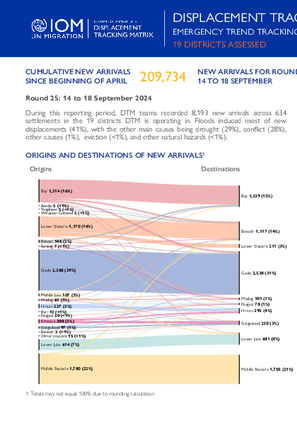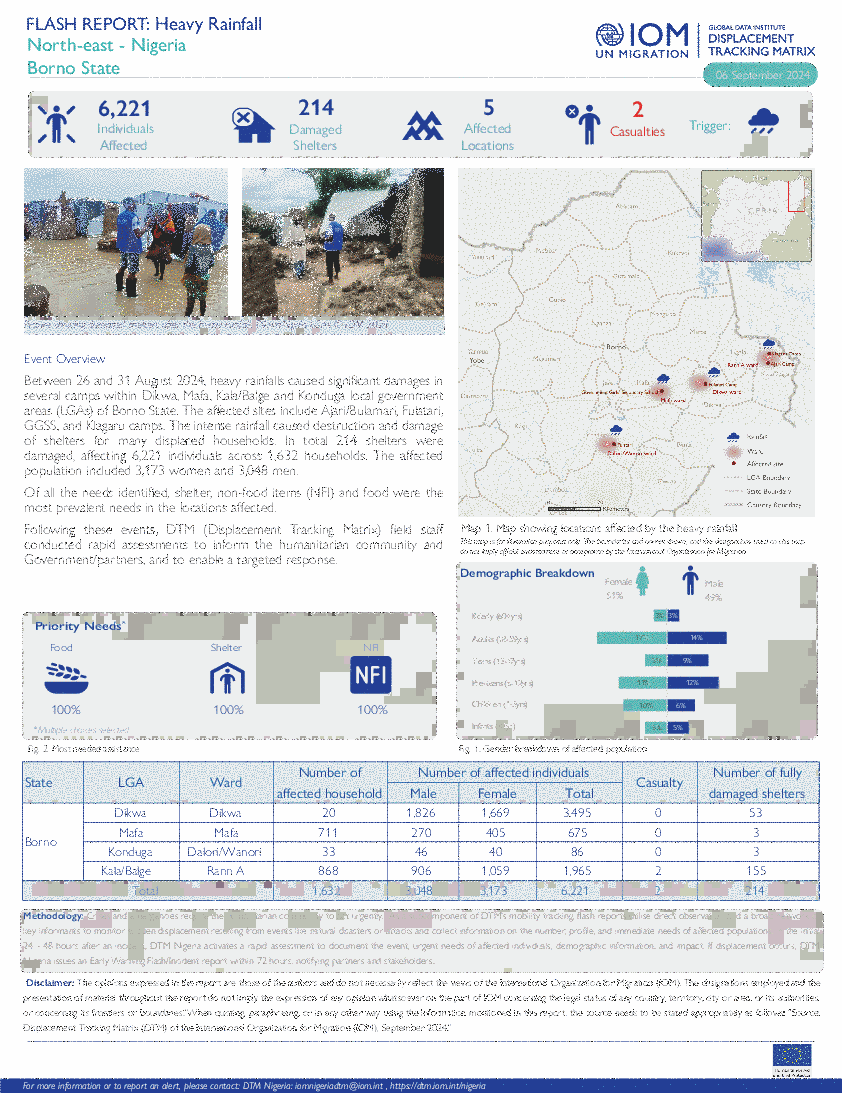-
Countries
-
Data and Analysis
-
Special Focus
-
Crisis Responses

Contact
DTM Nigeria, iomnigeriadtm@iom.int
Language
English
Location
Nigeria
Period Covered
Jul 01 2024
Jul 31 2024
Activity
- Flow Monitoring
- Flow Monitoring Registry
In July 2024, Transhumance Flow Monitoring tool identified 1,817 herders in Kaduna State and 723 herders in Katsina State. The herd count was estimated at 8,662 for Kaduna State and 2,981 for Katsina State. Notably, 97 per cent of the total number of herders departed from states within Nigeria, while the remaining three per cent departed from Niger.

Contact
MTM Kazakhstan (mtmkazakhstan@iom.int) DTM REMAP Support Team (dtmremapsupport@iom.int)
Language
English
Location
Kazakhstan
Period Covered
Feb 15 2024
Apr 30 2024
Activity
- Survey
- Return Intention
- Mobility Tracking
- Baseline Assessment
DTM implements the Baseline Mobility Assessment (BMA) in Kazakhstan to track mobility, provide information on population estimates, geographic distribution of migrant workers, return migrants, and emigrants, reasons for migration and countries of origin, return, and destination. Data is collected at the community (micro districts, townships, and villages) level from key informants and direct observations.
The Baseline Mobility Assessment (BMA) was conducted in seven oblasts or provinces (Abay, Almaty, Kostanay, Kyzylorda, Mangystau, North Kazakhstan, and Turkestan), and three major cities of Kazakhstan namely Shymkent city, Almaty city, and Astana city. This assessment covered 1,301 communities through interviews with 1,923 key informants. Based on the key informants' estimates, 598,094 international migrant workers were hosted in the assessed locations in Kazakhstan from 2020 to April 2024. Concurrently, 29,853 internal migrants were hosted in the assessed locations, and 3,224 Kazakh nationals were reported to be residing abroad as international migrants. In addition, 17,317 Kazakh migrants have returned from abroad.

Contact
DTM DRC, iomdrcdtm@iom.int
Language
English
Location
Democratic Republic of the Congo
Period Covered
Jun 01 2024
Aug 31 2024
Activity
- Mobility Tracking
- Baseline Assessment
The Democratic Republic of the Congo (DRC) has a complex internal displacement situation with a diverse set of drivers and impacts. In the country’s eastern provinces, armed conflict and insecurity have long been the primary drivers of the large-scale protracted displacement that the region experiences. On top of the large-scale humanitarian crisis in the east of the country, other regions of the DRC have experienced conflict, insecurity, and disasters such as floods and landslides. A complete understanding of the displacement situation across the entire DRC is vital to inform both near-term humanitarian assistance, as well as engaging a wider array of stakeholders involved in long-term programming. This report presents an updated country-level displacement overview produced by DTM in the DRC and combines data from targeted Mobility Tracking (MT) in the country’s four eastern provinces (conducted between July and August 2024) as well as from a separate exercise (known as MT Light), covering the remaining 22 provinces, for which data was collected between June and July 2024.

Contact
DTMPakistan@iom.int
Language
English
Location
Pakistan
Period Covered
Apr 01 2024
Jun 30 2024
Activity
- Flow Monitoring
This report provides key insights into the overall migration trends of Afghan nationals returning to Afghanistan, as well as an overview of the profiles of Afghan returnees and their mobility patterns, exploring routes, vulnerabilities, demographics and social characteristics.
Utilizing data collected at five border crossing points (BCPs) through FM methodology and harmonised with different relevant actors, IOM’s DTM recorded a total of 102,353 Afghan returns, including 99,731 (97%) returnees and 2,622 (3%) deportations between April and June 2024.
Key findings:
- During this second quarter (April - June 2024), both the number of returnees (99,731) and deportations (2,622) have increased significantly as compared to the number of returnees (53,291) and deportations (936) in the first quarter (January - March 2024).
- Most of the returnees are undocumented Afghans (80%), followed by PoR holders (18%) and ACC holders (2%).
- Vulnerable persons including chronically ill people, elderly individuals, persons with disabilities, and others account for two per cent of returns.
- Fear of arrest (89%) remains an important reason for Afghans to leave Pakistan.

Contact
DTM Somalia, IOMSomaliaDTM@iom.int
Language
English
Location
Somalia
Period Covered
Sep 14 2024
Sep 18 2024
Activity
- Mobility Tracking
- Baseline Assessment
This latest round of Emergency Trends Tracking was initiated in April 2024 to monitor displacements movements during the Gu rainy season. Districts covered in this round include Afgooye, Afmadow, Baardheere, Baidoa, Balcad, Belet Weyne, Belet Xaawo, Cabudwaaq, Dayniile, Dhuusamarreeb, Doolow, Gaalkacyo, Garoowe, Hodan, Jamaame, Jowhar, Kahda, Kismaayo, and Luuq. ETT is a crisis-based tool that tracks sudden displacement triggered by specific events or emerging crises.
The objective of ETT is to help prioritize humanitarian response and to enable partners to deliver rapid assistance. Based on previous shock induced displacement patterns, the humanitarian community expects that people will continue to move toward urban areas in search of humanitarian services. Consequently, the ETT coverage focuses on the main urban centers and surrounding villages for each assessed district. The data is collected through Key Informant Interviews (KIIs) at the location level, from Sunday to Wednesday every week. It includes information on new arrivals, numbers and demographic of IDPs, reasons for displacement, intentions, humanitarian assistance and priority needs among others.
To facilitate the joint analysis of the CCCM (Camp Coordination and Camp Management) Cluster’s New Arrivals Tracker (NAT) and ETT data, the assistance and needs indicators are identical in both tools.

Contact
DTM Nigeria, iomnigeriadtm@iom.int
Language
English
Location
Nigeria
Period Covered
Aug 26 2024
Sep 01 2024
Activity
- Mobility Tracking
- Event Tracking
Between 26 August and 1 September 2024, a total of 24 new arrivals were recorded at locations in Benue State. The new arrivals were recorded in Guma, Gwer west and Kwande local government areas (LGAs) of Benue State.

Contact
DTM Nigeria, iomnigeriadtm@iom.int
Language
English
Location
Nigeria
Period Covered
Aug 26 2024
Aug 31 2024
Activity
- Mobility Tracking
- Event Tracking
Between 26 and 31 August 2024, heavy rainfalls caused significant damages in several camps within Dikwa, Mafa, Kala/Balge and Konduga local government areas (LGAs) of Borno State. The affected sites include Ajari/Bulamari, Fulatari, GGSS, and Klagaru camps. The intense rainfall caused destruction and damage to shelters for many displaced households. In total 214 shelters were damaged, affecting 6,221 individuals across 1,632 households. The affected population included 3,173 women and 3,048 men.

Contact
DTM Nigeria, iomnigeriadtm@iom.int
Language
English
Location
Nigeria
Period Covered
Aug 18 2024
Aug 25 2024
Activity
- Mobility Tracking
- Event Tracking
Between 18 and 25 August 2024, northern Nigeria experienced severe storms and heavy rainfall, resulting in widespread displacement across the region. The impact was felt most acutely in Adamawa, Bauchi, Borno, and Gombe states.
In Adamawa, Numan LGA was hit the hardest as well, where a staggering 1,009 households and 5,844 individuals were impacted by the floodwaters. Madagali had 849 households and 1,324 individuals affected who struggled to cope with the flooding.
In Bauchi, Kafin Romi in Gamawa LGA faced extensive damages with 307 households and 1,036 people affected. Miya West in Ganjuwa LGA also felt the with 47 households and 276 individuals.
In Borno, Monguno LGA was heavily affected as well. The town of Monguno saw 315 households and 1,146 individuals displaced by the rising waters, struggling with the widespread damage.
Gombe, though less affected than some other states, still experienced flooding in certain areas. In Funakaye LGA, Ashaka/Magaba and Bajoga East faced significant challenges with 90 households and 722 individuals affected.

Contact
DTM Nigeria, iomnigeriadtm@iom.int
Language
English
Location
Nigeria
Period Covered
Jul 29 2024
Aug 04 2024
Activity
- Mobility Tracking
- Event Tracking
On 30 July 2024, armed bandits attacked the Kyado Market in Mbayenge ward and farmer-herders clash occured in the communities of Tse Pila (Ayati) in Borkiyo ward and Biliji in Mbatian ward of Ukum Local Government Area (LGA) in Benue State. There were reports of 208 injuries and nine fatalities. The attacks affected 838 individuals in 335 households and the clash affected 416 individuals in 96 households. The affected individuals included 390 children, 489 women and 375 men.
On 29 and 31 July, heavy rainfall occured in the communities of Kampany Amawa village in Gora ward of Zangon Kataf LGA and Ungwan Hausawa in Gidan Waya ward of Jema’a LGA of Kaduna State. There was a report of one fatalities. The rainfall affected 74 individuals in 9 household and flooded 14 shelters. The affect individuals included 48 children, 17 women and nine men.
On 29 July, 30 July and 01 August 2024, windstorm affected the communities of Zodawa in Dangani ward of Musawa LGA, Rijiyar Tsamiya in Daneji A in Sandamu LGA, Tsamiyar Lamo in Kawarin Kudi ward and Unguwar Galadima in Zango ward in Zango LGA and armed bandits attacked the communities of Yan Nasarawa in Daudawa ward and Ruwan Godiya in Ruwan Godiya ward of Faskari LGA in Katsina State. There were reports of 17 injuries and four fatalities. The attacks affected 1,070 individuals in 163 households and displaced them to Daudawa in Daudawa ward and Tafoki in Tafoki ward in Faskari LGA. The windstorm affected 294 individuals in 37 household. The affected individuals included 871 children, 352 women and 141 men.
On 31 July 2024, armed bandits attacked the community of Baga in Zungeru ward of Wushishi LGA in Niger State. The attack affected 160 individuals in 32 households, the affected included 123 children, 19 women and 18 men.
